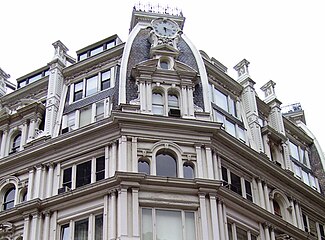Stephen Decatur Hatch




Stephen Decatur Hatch (1839–1894)[2] was a prominent late-19th century architect who was responsible for a number of historically or architecturally significant buildings in Manhattan, New York City and elsewhere. He primarily designed commercial buildings.[3]
Early life, family and education
[edit]This section needs expansion. You can help by adding to it. (September 2022) |
Stephen Hatch was born in Swanton, Vermont.[4] His father was an inventor.[3]
Career
[edit]Hatch relocated to New York City, finding employment as a construction inspector.[3] He joined the busy architectural firm of John B. Snook in 1860 as a draftsman.[4]
Hatch left the Snook firm around 1864 to start his own practice. He became the architect of the U.S. War Department, responsible for construction of military posts in New York.[3] His practice began to flourish in 1868.[4]
Personal life and demise
[edit]This section needs expansion. You can help by adding to it. (September 2022) |
Hatch died in 1894, during the construction of an extension to the headquarters building of the New York Life Insurance Company.
Works
[edit]- Manhattan
- 213-215 Water Street – warehouse, built 1868 for A.A. Thompson & Co., now part of South Street Seaport Museum,[5] within the South Street Seaport Historic District
- 118 East 18th Street – built 1868[6]
- Gilsey House Hotel – 1200 Broadway, built 1869–1871, converted to residential use 1980, a New York City landmark (1979)[1]
- 836-838 Broadway – built 1876-1877[7]
- Robbins & Appleton Building – manufacturing, built 1879–1880, a New York City landmark (1979)[8]
- Schepp Building – warehouse, 45-53 Hudson Street, built 1880, within the Tribeca North Historic District[9]
- 165 Duane Street – lofts, built 1881, within the Tribeca West Historic District[10]
- Murray Hill Hotel – Park Avenue between 40th and 41st Streets, built 1884, razed 1947[11]
- U.S. Army Building – also known as 3 New York Plaza, Water & Whitehall Streets, offices, built 1886[12]
- 168 Duane Street – warehouse, built 1886–1887, within the Tribeca West Historic District,[9] Dutch Revival style [13]
- Manhattan Savings Institution[14] – also known as Bleecker Tower,[15] 644 Broadway, built 1889–1891, within the NoHo Historic District [16]
- Fleming Smith Warehouse – 451-453 Washington Street, built 1891–1892, a New York City landmark (1978)[17]
- Roosevelt Building – lofts, 839-841 Broadway, built 1893[18]
- Former New York Life Insurance Company Building – also known as the Clock Tower Building, offices, 346 Broadway, built 1894–1895, completed by McKim, Mead & White, a New York City landmark (1987)[19] and on the National Register of Historic Places (1982)
- United States Custom House (now the Federal Hall National Memorial) and the American Surety Building, both located in lower Manhattan.
- Elsewhere
- Methodist Episcopal Church – Madison, New Jersey, built 1870, on the National Register of Historic Places (2008)
- Jubilee Hall – Fisk University, Nashville, Tennessee, built 1876, a National Historic Landmark (1974)
- Laclede Building – St. Louis, Missouri, built 1888[20]
- Eisenhower Executive Office Building, Rooms 231 & 232 – Washington, D.C., office suite for the U.S. Secretary of War, completed March 1888[2]
- Designed State Capitol building in Providence, Rhode Island.
References
[edit]- ^ a b NYCLPC p.80
- ^ a b "History of Rooms 231 and 232" on the White House website
- ^ a b c d "South Street Seaport Museum 213-215 Water Street" Historic American Buildings Survey, #NY-5684
- ^ a b c Dillon, James T. (September 11, 1979). Gilsey House Designation Report (PDF). New York City Landmark Preservation Commission – via neighborhoodpreservationcenter.org.
- ^ "South Street Seaport Museum, 213-215 Water Street, New York, New York, NY". loc.gov. Library of Congress Prints & Photographs Online Catalog.
- ^ "118 East 18th Street". preserve2.org. Gramercy Neighborhood Associates.
- ^ "836-838 Broadway" on the Endangered Cast-Iron Buildings website
- ^ New York City Landmark Preservation Commission, p. 62
- ^ a b New York City Landmark Preservation Commission, p. 21
- ^ White & Willensky, p.63
- ^ "Murray Hill Hotel, 1918". dspace.nitle.org. City University of New York.
- ^ White & Willensky, p. 26
- ^ "About Tribeca". cityrealty.com.
- ^ http://daytoninmanhattan.blogspot.com/2010/06/manhattan-savings-institute-644.html [user-generated source]
- ^ "Bleecker Tower" on Wired New York website
- ^ New York City Landmark Preservation Commission, p. 60
- ^ New York City Landmark Preservation Commission, p. 36
- ^ White & Willenski, p. 166
- ^ New York City Landmark Preservation Commission, p. 34
- ^ "The Gilsey House - 29th and Broadway" Accessed:2010-11-20
- New York City Landmarks Preservation Commission; Dolkart, Andrew S.; Postal, Matthew A. (2009). Postal, Matthew A. (ed.). Guide to New York City Landmarks (4th ed.). New York: John Wiley & Sons. ISBN 978-0-470-28963-1.
- White, Norval & Willensky, Elliot (2000). AIA Guide to New York City (4th ed.). New York: Three Rivers Press. ISBN 978-0-8129-3107-5.
External links
[edit] Media related to Stephen Decatur Hatch at Wikimedia Commons
Media related to Stephen Decatur Hatch at Wikimedia Commons
